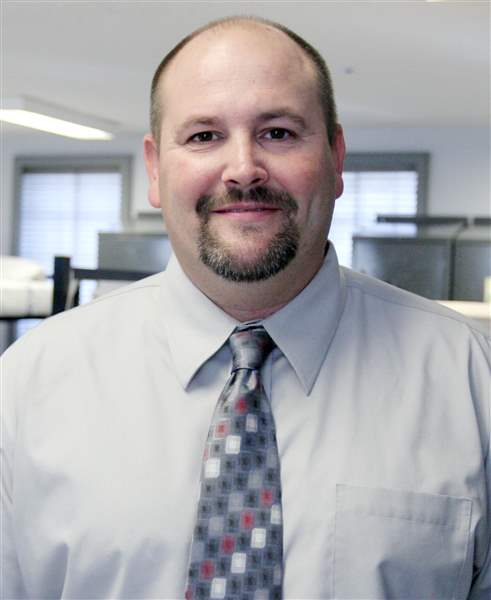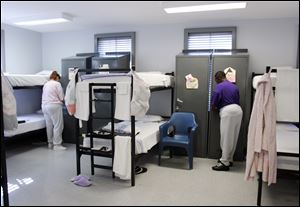
Treatment center reopens floor to help more offenders
11/8/2009
Bud Hite is director of the facility at Jefferson and 12th streets, one of 18 such treatment programs in Ohio.
The Blade/Lisa Dutton
Buy This Image

Carla Davis, left, and Angela Hayes are among the people sent to the Correctional Treatment Facility in downtown Toledo. The facility is used for court-ordered treatment in a residential setting.
For more than a decade, the dormitory on the sixth floor of the Correctional Treatment Facility has been dark - shuttered not by lack of need, but by a lack of money.
But with a prison system bursting at the seams and diversion programs such as the treatment facility proved to be working, the floor, new staff, and the opportunity for more treatment are again open to Lucas County offenders.
A community-based correctional facility funded by the state, the Correctional Treatment Facility provides treatment for nonviolent felon offenders who are sentenced through common pleas court. Traditionally, the program predominantly focused on substance abuse treatment, mental health, and education. But with $482,000 added this year by the Ohio Department of Rehabilitation and Correction to the facility's $4.06 million budget, officials can work with offenders with other types of problems, Director Bud Hite said.
And as of Oct. 1, the sixth floor is officially open.
"It was huge," Mr. Hite said.

Bud Hite is director of the facility at Jefferson and 12th streets, one of 18 such treatment programs in Ohio.
The funding helped open an additional 24 beds and hire 10 staff members. "Now we can give high-risk offenders the high-risk treatment they need."
Opened in 1994 at the corner of Jefferson and 12th streets, the treatment facility is one of 18 such facilities in the state. During the state's 2009 fiscal year, which runs from July to June, the facilities statewide provided services to about 5,600 offenders.
With additional money opening more beds, about 6,300 people are expected to receive services statewide next fiscal year, Mr. Hite said.
The program is a lock-down facility where offenders participate in chemical dependency treatment and work to address behavioral issues. Participants work through various phases and at the end of their sentences are released into an after-care program that coordinates closely with the county's probation department, Mr. Hite said.
And if they fail to comply, they face violations of their community control and possible prison time.
Last month, officials opened the top floor as the new women's dormitory and began accepting more participants. People who did not have drug problems but who judges said needed structure and cognitive behavioral treatment could more easily be diverted from prison into the program.
Lucas County Common Pleas Judge Gene Zmuda said the new space opened another sentencing option for judges. It also offers a place to send offenders granted an early release from prison, he said.
"I like the fact that it is a structured environment. This is one way of establishing that type of structure in their lives," the judge said. "The trick to this is, how do you find the cases that would be appropriate for it? That's where pretrial services excel in that they suggest alternate sentencing for appropriate individuals in the presentence reports."
Alicia Handwerk, chief of the Ohio Department of Rehabilitation and Correction's Bureau of Community Sanctions, said community treatment is "definitely more effective," especially with those sentenced for lower-level felonies. She said that although these offenders are often more likely to repeat, they are usually not violent and fare better in the community where they have ties.
It also helps address the overcrowding problem at the prisons.
"These programs are not just for drug addictions, they really focus on what things make an offender an offender, including criminal thinking and the types of people they associate with," she said. "It tries to point out to them, 'You're making mistakes in your thinking. Here's a better way of thinking and here's a chance to work on them.'•"
Mr. Hite said of those who complete the local treatment program, about 38.5 percent fall back into the system, a number far less than the approximate 55 percent recidivism rate nationally.
And as more people are diverted from the prison system, less money is spent on incarceration, he added.
"We're very effective and getting more effective," he said.
Contact Erica Blake at:
eblake@theblade.com
or 419-213-2134.